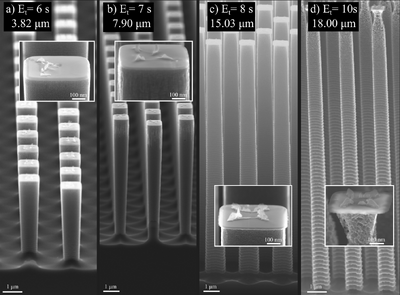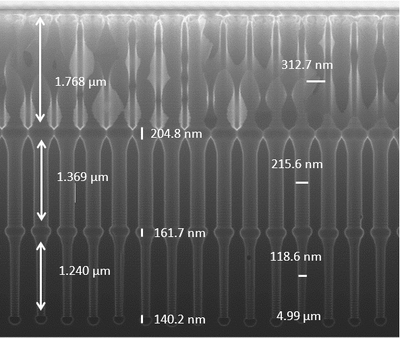Specific Process Knowledge/Etch/DRIE-Pegasus/Pegasus-2/ORE with Al2O3 mask
Feedback to this page: click here
THIS PAGE IS UNDER CONSTRUCTION
Al2O3 mask
By Maria Farinha @Nanolab Internal, Jan 2023
Important! The pressure settings used below may no longer be permitted, always check with the Dry etch group.
As stated by Nguyen et al., the SF6 and O2 fluxes are only separated after 4 s during the C-step. Shorter time steps than that do not execute the function of the clearing. After testing recipes with only 2 s of clearing and with no clear step, it was understood it could be eliminated, showing more depth as well as less undercut when going for shorter cycles. From then on, not CORE but ORE recipes were applied D/E = O/RE.
Moreover, during the E-step, the MFC (mass flow controller) presented a delay to read the pressure when compared with the power, creating unwanted bias. To fight it, the E-step was divided into E1 and E2. The E1 of only 2 s is enough to stabilize the pressure, and E2 the profile is etch correctly, without the unwanted bias.

Going further, the process is set with 4 steps, Oxidize, Removal, E1 and E2 steps. In the E1, the pressure will rise, without power applied, so that for the E2 the pressure is already rising and the power starts to be applied.
Pillars
Using patterned samples of 1 μm pillars with 50 nm of Al2O3. After the tests, approximately 32nm of Al2O3 were still intact. During the recipe, Pegasus 2 conditions were: Outer EM=10A, T=20°C, no clamping, no He BGC, no coil power and all heaters OFF.

| Time (s) | Pressure (valve control) | O2 flow (SCCM) | SF6 flow (SCCM) | Platen power (W) | |
|---|---|---|---|---|---|
| O-step | 10 | 3% | 200 | 0 | 40 |
| R-step | 10 | 100% | 0 | 5 | 40 |
| E1-step | 2 | 4% | 0 | 350 | 40 |
| E2-step | 7 | 4% | 0 | 350 | 300 |
* Pillars profile effect when varying the etch time.
Holes
Using patterned samples of 1 μm holes with 50 nm of Al2O3. After the tests, approximately 28nm of Al2O3 were still intact. When using this recipe, by adjusting the number of cycles, approximately 10 μm were achieved maintaining a straight profile. When going for deeper profiles, 17 μm were also achieved, but the profile starts to get positive. Further work may solve the issue. During the recipe, Pegasus 2 conditions were: Outer EM=10A, T=20°C, no clamping, no He BGC and all heaters OFF.

| Time (s) | Pressure | O2 flow (SCCM) | SF6 flow (SCCM) | Platen power (W) | Coil power (W) | |
|---|---|---|---|---|---|---|
| O-step | 10 | 220 mTorr | 200 | 0 | 40 | 0 |
| R-step | 10 | 100% | 0 | 40 | 40 | 0 |
| E1-step | 2 | 220 mTorr | 0 | 1200 | 0 | 0 |
| E2-step | 1-5 | 220 mTorr | 0 | 1200 | 1 | 2000 |
* For #288 cycles, 120 min, the profile depth reaches 17.6 μm. For #144 cycles, 60 min, the profile depth reaches 10.1 μm. Width variation presented in the pictures.
Nanoholes
The nanoholes are 200nm wide, with 400nm pitch with 100 nm Al2O3 mask. During the recipe, Pegasus 2 conditions were: Outer EM=10A, T=20°C, no clamping, no He BGC and all heaters OFF.

| Time (s) | Pressure (valve control) | O2 flow (SCCM) | SF6 flow (SCCM) | Platen power (W) | |
|---|---|---|---|---|---|
| O-step | 10 | 220 mTorr | 200 | 0 | 40 |
| R-step | 10 | 100% | 0 | 40 | * |
| E1-step | 2 | 220 mTorr | 0 | 350 | 0 |
| E2-step | 0-15 | 220 mTorr | 0 | 350 | 100-300 |
*The R-power value was changed and observed.
The most suitable removal power was 40 W, removing the bottom of the profile correctly without damaging the top part of the profile.

| Time (s) | Pressure (valve control) | O2 flow (SCCM) | SF6 flow (SCCM) | Platen power (W) | |
|---|---|---|---|---|---|
| O-step | 10 | 220 mTorr | 200 | 0 | 40 |
| R-step | 10 | 100% | 0 | 40 | 40 |
| E1-step | 2 | 220 mTorr | 0 | 350 | 40 |
| E2-step | * | 220 mTorr | 0 | 350 | 300 |
*The E2-time value was changed and observed.
Regarding the measurements of the profiles, in a) the depth reached 3.17 µm with 0-15s of ramping, b) reached 3.21 µm with 1-15s of ramping, c) reached 2.87 µm whit 5-15s of ramping and d) reached 3.63 µm with 15 s without ramping.
Isotropic etch
Some isotropic etches were performed, intercalated with anisotropic etches. The nanoholes are 200nm wide, with 400nm pitch with 100 nm Al2O3 mask. The recipe presented in the table was repeated either 2 or 3 times in order to achieve the picture results. During the recipe, Pegasus 2 conditions were: Outer EM=10A, T=20°C, no clamping, no He BGC and all heaters OFF.

| Time (s) | Pressure | O2 flow (SCCM) | SF6 flow (SCCM) | Platen power (W) | Coil power (W) | ||
| Nanoholes etch | O-step | 10 | 220 mTorr | 200 | 0 | 40 | 0 |
| R-step | 10 | 100% | 0 | 0 | 40 | 0 | |
| E1-step | 2 | 220 mTorr | 0 | 350 | 0 | 0 | |
| E2-step | 0-15 | 220 mTorr | 0 | 350 | 100-300 | 0 | |
| Isotropic etch | O-step | 30 | 200 mTorr | 200 | 0 | 0 | 2000 |
| R-step | 30 | 100% | 0 | 40 | 40 | 0 | |
| E-step | 20 | 200 mTorr | 0 | 1200 | 0 | 2000 |

